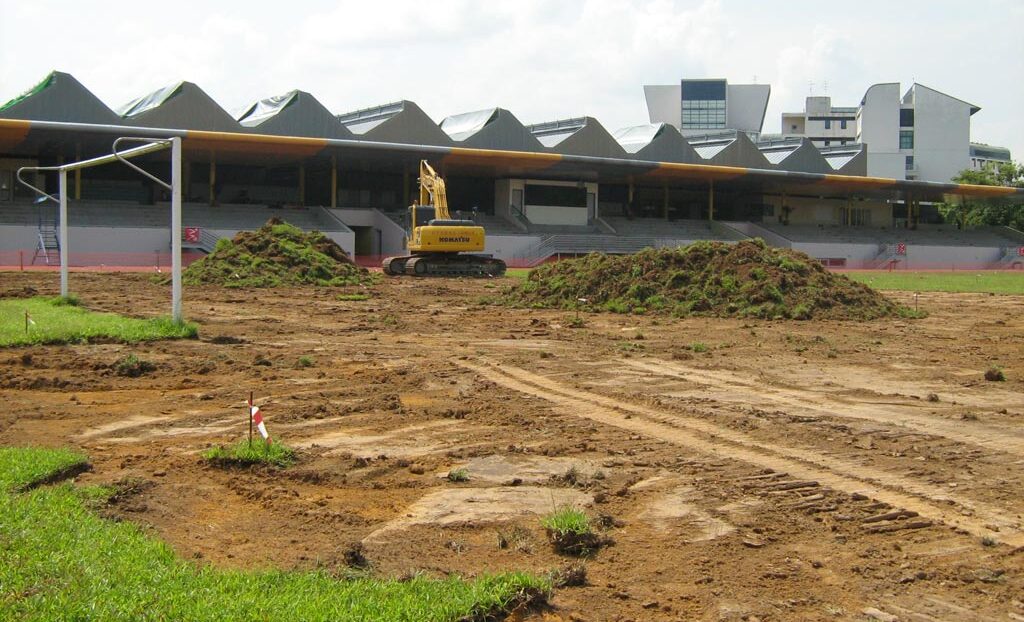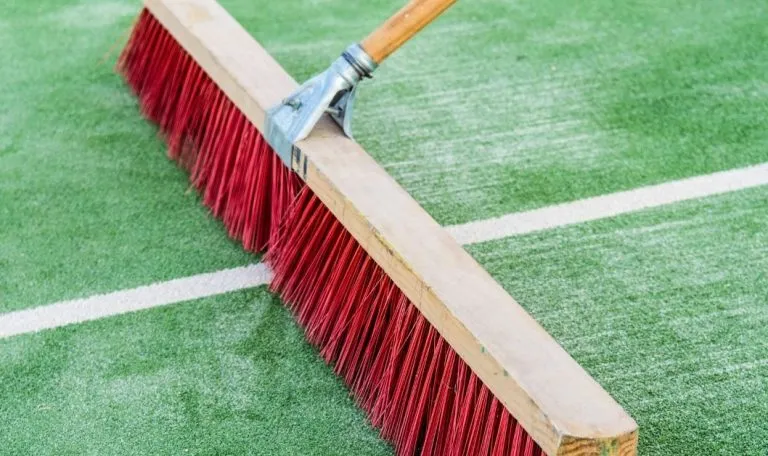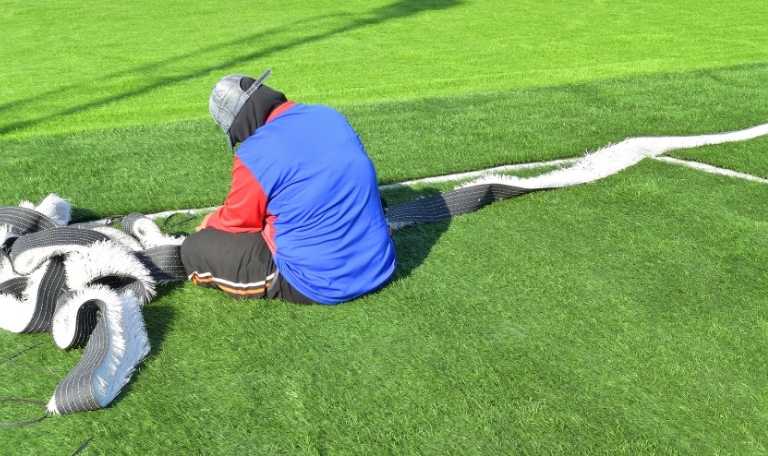Astro Turf Experts in
Soccer Field Constrcution
Looking For a Standard Soccer Field or 5-Aside Soccer Pitch? LawnKing specialises in the construction, maintenance and resurfacing of soccer fields/pitches in South Africa and beyond!
Our Soccer Filed Services

Construction
We have the teams and equipment for soccer field construction from start to finish anywheere in Africa.

Maintenance
With all the traffic and constant battering, your soccer pitch requires a professional maintenance plan.

Repairs & Resurfacing
We assist with timely and excellent soccer field repair and resurfacing services anywhere in Africa.
Soccer Field Construction Guide

Constructing a soccer field is a meticulous process that requires careful planning, precise execution, and the highest standards of quality control. At LawnKing Gardens, we pride ourselves on delivering world-class soccer fields that meet both international standards and the specific needs of our clients. Below is a detailed guide on the process, supplies, and steps involved in constructing a top-tier soccer field, along with the quality control measures we implement to ensure excellence.
Planning and Design
Site Assessment and Surveying
The first step in soccer field construction is a comprehensive site assessment. This involves surveying the land to determine its topography, soil composition, drainage capacity, and any potential obstacles. At LawnKing Gardens, our expert team uses advanced GPS and laser-guided technology to conduct precise surveys, ensuring that the field is laid out accurately and efficiently.
Design and Layout
Once the site has been assessed, we work closely with our clients to design a soccer field that meets their specific requirements. This includes deciding on the field dimensions, orientation, and any additional features such as seating, lighting, and irrigation systems. Our designs are tailored to comply with FIFA regulations or other relevant standards, ensuring that the field is suitable for competitive play.
Construction Process
Excavation and Grading
The construction process begins with excavation and grading. This involves removing the topsoil and leveling the ground to create a stable base for the field. Proper grading is crucial to ensure even water drainage, which prevents waterlogging and maintains the integrity of the playing surface. At LawnKing Gardens, we use laser-guided grading equipment to achieve precise leveling and optimal drainage.
Drainage System Installation
A well-designed drainage system is essential for the longevity and performance of a soccer field. We install a network of perforated pipes beneath the field, which is connected to a central drainage outlet. This system efficiently channels excess water away from the playing surface, preventing water accumulation and ensuring that the field remains playable in all weather conditions.
Base Layer Construction
After the drainage system is in place, we construct the base layer of the field. This typically consists of a layer of crushed stone or gravel, which provides a stable foundation for the playing surface. The base layer is compacted to ensure uniformity and stability, with particular attention paid to achieving the correct gradient for drainage. Quality control is strictly enforced at this stage, with regular compaction tests conducted to ensure the base meets our high standards.
Installation of Irrigation System
To maintain a healthy playing surface, an efficient irrigation system is crucial. At LawnKing Gardens, we install state-of-the-art sprinkler systems that are designed to deliver even water distribution across the entire field. These systems are carefully calibrated to meet the specific water needs of the grass species chosen for the field, ensuring optimal growth and durability.
Laying the Playing Surface
The final step in the construction process is laying the playing surface. Depending on the client’s preference, this may involve the installation of natural grass or artificial turf.
Natural Grass Installation
For natural grass fields, we select a high-quality grass species that is well-suited to the local climate and soil conditions. The grass is typically laid in sods or sprigs, with care taken to ensure even coverage and proper root establishment. Fertilization and watering schedules are implemented to promote healthy growth and establish a resilient playing surface.
Artificial Turf Installation
If artificial turf is chosen, we use only the highest quality materials that mimic the look and feel of natural grass. The turf is carefully unrolled and secured to the base layer, with seams meticulously joined to create a seamless playing surface. Infill material, such as silica sand or rubber granules, is then applied to enhance the turf’s performance and provide cushioning.
Material Quality Assurance
At LawnKing Gardens, we source all construction materials from reputable suppliers who meet our stringent quality standards. This includes ensuring that the turf, irrigation components, and drainage materials are durable, environmentally friendly, and compliant with industry standards.
Regular Inspections
Throughout the construction process, our project managers conduct regular inspections to ensure that each stage meets our quality benchmarks. This includes checking the accuracy of the grading, the integrity of the drainage system, and the evenness of the playing surface. Any issues identified are promptly addressed to maintain the highest standards of quality.
Post-Construction Testing
Once the field is completed, we conduct a series of tests to verify its readiness for play. This includes assessing the firmness of the playing surface, the effectiveness of the drainage system, and the evenness of the grass or turf. Only after these tests have been successfully completed do we hand over the field to the client.
Maintenance and Aftercare
After the construction is complete, LawnKing Gardens provides comprehensive maintenance services to ensure the longevity and performance of the soccer field. This includes regular mowing, fertilization, irrigation system checks, and, if necessary, repairs to the turf or drainage system.
Dimensions:
- Length: 100–110 meters (328–361 feet)
- Width: 64–75 meters (210–246 feet)
The size of a standard soccer field can vary slightly depending on the competition and the specific location, but FIFA’s regulations set the above range for professional matches. The goalposts are 7.32 meters (24 feet) apart, and the crossbar is 2.44 meters (8 feet) above the ground. The penalty area extends 16.5 meters (18 yards) from the goal line.
Applications:
- Professional Matches: The standard field size is used in most professional leagues, including the English Premier League, La Liga, and international competitions like the FIFA World Cup.
- Amateur and Youth Games: These fields are also used at various levels of amateur and youth soccer, though the dimensions might be adjusted slightly to accommodate younger players.
- Training: Professional teams use standard-sized fields for full-team training sessions to simulate match conditions.
2. 5-a-side Soccer Field
Dimensions:
- Length: 25–42 meters (82–138 feet)
- Width: 16–25 meters (52–82 feet)
The size of a 5-a-side soccer field is much smaller compared to a standard field. There are no fixed dimensions, but they generally fall within the range mentioned above. The goals are also smaller, typically measuring 3 meters (9.84 feet) wide and 2 meters (6.56 feet) high.
Applications:
- Urban Soccer: 5-a-side is popular in urban areas where space is limited. It’s often played on artificial turf, indoors, or in enclosed outdoor pitches.
- Recreational Play: The smaller size is perfect for recreational matches, where the focus is on fun and fitness rather than professional-level competition.
- Youth Training: 5-a-side fields are commonly used for training younger players. The smaller pitch helps players improve their skills in tight spaces and emphasizes ball control and quick passing.
- Corporate and Community Leagues: Many corporate and community leagues opt for 5-a-side games, as they require fewer players and smaller pitches, making it easier to organize and play.
Comparison of Dimensions and Applications:
Size: The standard 11-a-side field is significantly larger, suitable for full-team matches, while the 5-a-side field is more compact, designed for fewer players and quicker play.
Usage: Standard fields are used for professional and high-level amateur matches, while 5-a-side fields are more versatile, often used for recreational play, youth training, and community leagues.
Play Style: The larger standard field allows for more strategic, long-passing gameplay, while the smaller 5-a-side field promotes quick, skillful play with an emphasis on ball control.
In summary, the choice between a standard and 5-a-side field depends on the level of play, the number of participants, and the available space. Each type of field serves a different purpose, catering to various aspects of the game of soccer.
For Soccer Pitch Construction, Quotes, contact us.
Soccer Field Repair and Maintenance
Soccer field repair and maintenance services encompass a range of activities designed to ensure that the playing surface remains in optimal condition throughout the year. These services include regular mowing, aeration, fertilization, and irrigation to maintain healthy grass, as well as repairing worn or damaged areas, such as goalmouths and high-traffic zones. Additionally, services may involve overseeding, topdressing, and soil testing to promote robust turf growth. For artificial fields, maintenance includes infill replenishment, surface grooming, and cleaning. Proper drainage systems are also inspected and maintained to prevent waterlogging. These efforts ensure a safe, playable surface that meets the standards required for both amateur and professional soccer.
Get A Free Quote!
FAQs
Whether you’re curious about features, a free estimate, or even site inspection, we’re here to answer any questions regarding Soccer Field/ Pitch Construction, Maintenance and Repair.
Q: What are the primary considerations for constructing a standard-size soccer field in South Africa?
A: Constructing a standard-size soccer field involves several critical considerations. The field must adhere to FIFA’s guidelines, which specify dimensions between 100 to 110 meters in length and 64 to 75 meters in width. Soil quality is paramount; the ground should be well-drained and level to prevent waterlogging and uneven surfaces. The construction process includes site preparation, grading, and the installation of drainage systems to ensure proper water runoff. Additionally, the choice of turf—whether natural or synthetic—affects the overall maintenance and durability of the field. Regular testing and preparation of the soil before laying the turf can prevent future problems.
Q: What maintenance practices are essential for a standard soccer field?
A: Regular maintenance is crucial to keep a standard soccer field in top condition. This includes consistent mowing to maintain the grass at an optimal height, typically between 25 to 30 millimeters, and periodic aeration to alleviate soil compaction. Fertilization schedules should be followed to promote healthy grass growth, and irrigation systems need to be adjusted based on seasonal weather conditions. It is also important to inspect and repair any wear and tear on the field, such as damaged goal areas or divots caused by play. Implementing a routine maintenance plan helps ensure the field remains safe and playable.
Q: How does the maintenance of a 5-a-side soccer field differ from a standard field?
A: The maintenance of a 5-a-side soccer field differs primarily due to its smaller size and higher intensity of use. These fields, which are usually between 25 to 42 meters in length and 16 to 25 meters in width, often experience more concentrated wear in smaller areas. Regular cleaning and brushing of artificial surfaces are necessary to prevent debris buildup and maintain even infill distribution. For natural turf fields, more frequent mowing and fertilization might be required due to the higher frequency of play. Both types of 5-a-side fields require regular inspection to address any damage promptly and to ensure proper drainage and surface quality.
Q: What are common repair issues for soccer fields and how can they be addressed?
A: Common repair issues for soccer fields include worn-out goal areas, uneven surfaces, and drainage problems. For natural turf fields, repairing worn areas involves reseeding or overseeding and sometimes applying topdressing to level the surface. For artificial fields, issues like uneven infill distribution or surface wear can be addressed by adding or redistributing infill material and conducting regular surface grooming. Drainage problems require inspecting and repairing the drainage system to prevent water accumulation, which can lead to further damage. Prompt attention to these issues helps maintain the field’s safety and playability.
Q: How often should soccer fields be inspected for maintenance and repair needs?
A: Soccer fields should be inspected regularly to ensure they remain in optimal condition. For standard-size fields, inspections should be conducted at least monthly to check for wear, damage, and overall turf health. More frequent inspections might be needed during periods of heavy use or after adverse weather conditions. For 5-a-side fields, especially those with artificial surfaces, weekly inspections are often necessary to address minor issues before they become significant problems. Regular inspections help identify and address maintenance and repair needs promptly, ensuring the field remains safe and functional.
All our Locations
Tree Felling Randburg | Tree Felling Atholl | Tree Felling Dunkeld | Tree Felling Fairland | Tree Felling Fairlands | Tree Felling Ferndale | Tree Feling Hyde Park | Free Felling Inanda | Tree Felling Northcliff | Tree Felling Sandhurst | Tree Felling Strydjom Park | Tree Felling Greenside | Tree Felling Constantia Kloof | Tree Felling Douglasdale | Tree Felling Olivedale | Tree Felling Westcliff | Tree Felling Westdene | Tree Felling Linden | Tree Felling Blairgowrie | Tree Felling Centurion | Tree Felling Waterkloof | Tree Felling Weltevreden Park
